
The Viperinae, or viperines, are a subfamily of venomous vipers endemic to Europe, Asia and Africa. They are distinguished by their lack of the heat-sensing pit organs that characterize their sister group, the subfamily Crotalinae. Currently, 13 genera are recognized. Most are tropical and subtropical, although one species, Vipera berus, even occurs within the Arctic Circle.

Bitis is a genus of venomous vipers found in Africa and the southern Arabian Peninsula. It includes the largest and the smallest vipers in the world. Members are known for their characteristic threat displays that involve inflating and deflating their bodies while hissing and puffing loudly. The type species for this genus is B. arietans, which is also the most widely distributed viper in Africa. Currently, 15 species are recognized.

Bitis nasicornis is a venomous viper species found in the forests of West and Central Africa. A large viper, known for its striking coloration and prominent nasal "horns." No subspecies are currently recognized.
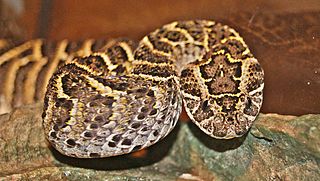
The puff adder is a venomous viper species found in savannah and grasslands from Morocco and western Arabia throughout Africa except for the Sahara and rainforest regions. It is responsible for causing the most snakebite fatalities in Africa owing to various factors, such as its wide distribution, frequent occurrence in highly populated regions, and aggressive disposition. Two subspecies are currently recognized, including the nominate subspecies described here.
Bitis arietans somalica also known as the Somali puff adder, is a venomous viper subspecies found only in Somalia, Somaliland, eastern Ethiopia, and northern Kenya. It is distinguished from B. a. arietans by its keeled subcaudals.

The berg adder is a small, venomous viper species endemic to mountainous regions in southern Africa. No subspecies are currently recognized.
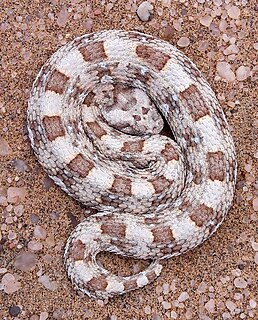
The horned adder is a venomous viper species found in the arid region of southwest Africa, easily distinguished by the presence of a single, large horn-like scale over each eye. No subspecies are currently recognized.

The many-horned adder is a venomous viper species found in certain rocky desert areas, mostly along the Atlantic coast of southern Africa. They have characteristic tufts of "horns" above each eye. no subspecies are currently recognized.
The Albany adder is a viper species. It was previously considered a subspecies of Bitis cornuta. Its range is restricted to eastern and southern Cape Province in South Africa. Like all vipers, it is venomous.
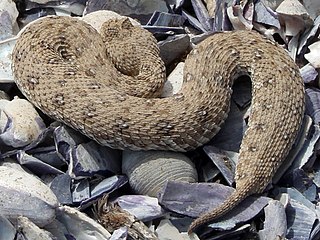
Bitis schneideri is a species of venomous snake in the subfamily Viperinae of the family Viperidae. The species is native to a small coastal region that straddles the border between Namibia and South Africa. B. scneideri is the smallest species in the genus Bitis and possibly the world's smallest viper. There are no subspecies that are currently recognized as being valid.

Bitis inornata is a venomous viper species found only in Cape Province, South Africa. No subspecies are currently recognized.

Bitis parviocula is a venomous viper species found only in Ethiopia. It is large with a broad head and spectacular geometric markings. In 1995, the species was known from only three specimens, but additional information has surfaced since then. Little is known about its natural history or its venom. No subspecies are currently recognized.

Bitis peringueyi, also known as the Peringuey's adder, Peringuey's desert adder or sidewinding adder, is a venomous viper species found in Namibia and southern Angola. No subspecies are currently recognized.
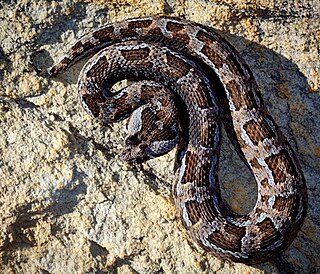
The red adder is a venomous viper species found only in Western Cape Province, South Africa. No subspecies are currently recognized.
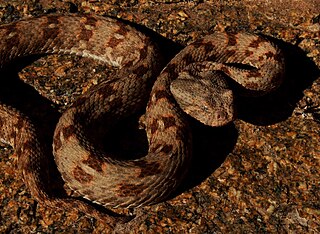
Bitis xeropaga is a venomous viper species found in southern Namibia and northwestern Cape Province in South Africa. No subspecies are currently recognized.

Bitis rhinoceros is a viper species endemic to West Africa. Like all vipers, it is venomous. It can be easily distinguished from the closely related species B. gabonica by the presence of two large nasal "horns".
Causus bilineatus is a venomous viper species endemic to south central Africa. No subspecies are currently recognized. Common names include lined night adder and two-striped night adder.

Python anchietae is a nonvenomous python species endemic to southern Africa. According to Donald George Broadley (1990), this species is most closely related to the ball python of western Africa, and no subspecies are currently recognized. It is named after the Portuguese naturalist and explorer José Alberto de Oliveira Anchieta.
Letheobia newtoni is a species of snake in the family Typhlopidae.















